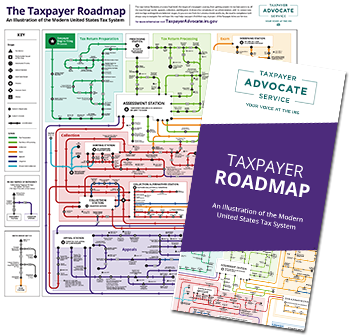Pay Tax Due in Full
View our interactive tax map to see where you are in the tax process. It could help you navigate your way through the IRS.
View our interactive tax map to see where you are in the tax process. It could help you navigate your way through the IRS.

You received a notice or letter from the IRS and either choose to respond to the notice or letter and/or lien or levy by paying your tax balance in full.
This notice or letter may include additional topics that have not yet been covered here. Please check back frequently for updates.
You have a balance on your tax account, so the IRS sent you a notice or letter. If the IRS still did not hear from you, it sent you notice that a Notice of Federal Tax Lien was filed and/or a notice of levy or a notice proposing a levy, letting you know how much you owe, when it’s due, how to pay and that you have the right to appeal this action. If the IRS does not hear from you, it will continue with its collection process.
For example, if you have a tax debt, the IRS can issue a levy, which is a legal seizure of your property or assets. It is different from a lien — while a lien makes a claim to your assets as security for a tax debt, the levy takes your property (such as funds from a bank account, Social Security benefits, wages, your car, or your home). For specifics, see Levies and Liens.
You have a balance on your tax account, so the IRS sent you a notice or letter
The first thing to do is to check the return address to be sure it’s from the Internal Revenue Service and not another agency.
If it’s from the IRS, the notice will have instructions on how to respond. If you want more details about your tax account, you can order a transcript. For specifics, see I got a notice from the IRS.
If you believe the balance is correct and you wish to and can pay your taxes in full, you can do this by:
If you disagree with the notice, call the IRS at the toll-free number on the top right corner of your notice. Please have your paperwork (such as cancelled checks, amended return, etc.) ready when you call. See also Publication 5, Your Appeal Rights and How to Prepare a Protest If You Don’t Agree.
If you wish to appeal this proposed levy action or lien filing, you’ll have until the date shown on the notice to request a Collection Due Process (CDP) hearing with the IRS Independent Office of Appeals (Appeals). This deadline cannot be extended for any reason. If your request for a CDP hearing isn’t timely, you can request an Equivalent Hearing within one year from the date of the CDP notice, but you can’t go to court if you disagree with Appeals’ decision. See Publication 1660, Collection Appeal Rights, for a full explanation of the CDP process and the Equivalent Hearing process.
If the IRS has already issued a CDP notice for that particular tax debt, then you can still request a hearing with Appeals either before or after the IRS levies your property or files a lien. You will need to request a conference through the Collection Appeals Program (CAP), but unlike a CDP hearing, you may not seek review of Appeals’ determination in the U.S. Tax Court. See Publication 1660, Collection Appeal Rights, for a full explanation of the CAP.
If you believe you have an acceptable reason for interest or a penalty to be removed or reduce, you may complete Form 843, Claim for Refund and Request for Abatement, or send a signed statement to the IRS explaining your reason why. For specific instructions, see Notice 746, Information About Your Notice, Penalty and Interest.
If you believe you have overpaid your taxes, you can file a refund claim asking for the money back; however, there are specific time frames in which you must file your claim. For more information, see Publication 556, Examination of Returns, Appeal Rights, and Claims for Refund.
For more specifics on your particular notice, visit Understanding your IRS Notice or Letter.

Understanding your notice or letter
For more specifics on your notice, visit Understanding your IRS Notice or Letter on IRS.gov
Get Help topics
Browse common tax issues and situations at TAS Get Help
If you still need help
The Taxpayer Advocate Service is an independent organization within the IRS that helps taxpayers and protects taxpayers’ rights. We can offer you help if your tax problem is causing a financial difficulty, you’ve tried and been unable to resolve your issue with the IRS, or you believe an IRS system, process, or procedure just isn’t working as it should. If you qualify for our assistance, which is always free, we will do everything possible to help you.
Visit dev.taxpayeradvocate.irs.gov or call ![]() 1-877-777-4778.
1-877-777-4778.
Low Income Taxpayer Clinics (LITCs) are independent from the IRS and TAS. LITCs represent individuals whose income is below a certain level and who need to resolve tax problems with the IRS. LITCs can represent taxpayers in audits, appeals, and tax collection disputes before the IRS and in court. In addition, LITCs can provide information about taxpayer rights and responsibilities in different languages for individuals who speak English as a second language. Services are offered for free or a small fee. For more information or to find an LITC near you, see the LITC page on the TAS website or Publication 4134, Low Income Taxpayer Clinic List.
Notice of Intent to Levy and Your Notice of a Right to a Hearing, Letter 11 (LT11)